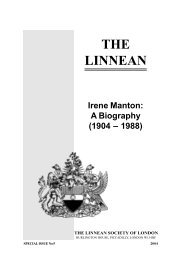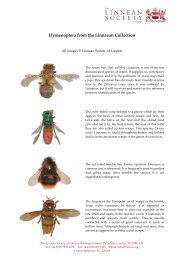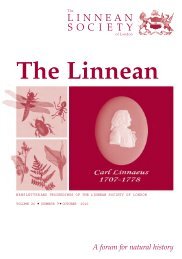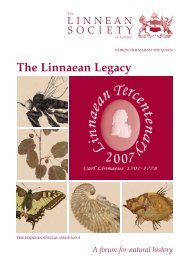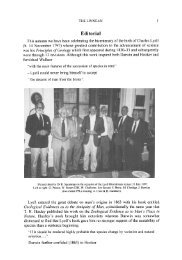Vol 25, no 3, October - The Linnean Society of London
Vol 25, no 3, October - The Linnean Society of London
Vol 25, no 3, October - The Linnean Society of London
You also want an ePaper? Increase the reach of your titles
YUMPU automatically turns print PDFs into web optimized ePapers that Google loves.
36<br />
THE LINNEAN 2009 VOLUME <strong>25</strong>(3)<br />
Darwin’s Lichens<br />
David J. Galloway, FLS<br />
Landcare Research, Private Bag 1930, Dunedin 9054, New Zealand<br />
(gallowayd@xtra.co.nz)<br />
Introduction<br />
In 1992-1993, I helped the late Pr<strong>of</strong>. David L. Yudilevich (1930-2006) (see Mann<br />
2006) coordinate an international symposium, “Darwin and the Beagle in Chile:<br />
Evolution Today”, at the University <strong>of</strong> Chile in Santiago, Chile (29 September-1<br />
<strong>October</strong> 1993) as part <strong>of</strong> the ICSU General Assembly meetings held at that time in<br />
Santiago. <strong>The</strong> symposium was wide-ranging, covering the major themes <strong>of</strong> Geology,<br />
Palaeontology, Evolution & Genetics, Botany, Zoology, Ecology, Medicine &<br />
Psychology, Anthropology, History, Philosophy and Religion. To this symposium I<br />
contributed an account <strong>of</strong> Darwin’s lichens (Galloway 1993a). Although David<br />
Yudilevich later produced a fine book on Darwin in Chile (Yudilevich & Castro Le-<br />
Fort (1995), based very much on the Symposium and its associated Darwin Exhibition<br />
(to which the <strong>Linnean</strong> <strong>Society</strong> contributed a life-size copy <strong>of</strong> the Collier portrait <strong>of</strong><br />
Darwin from the <strong>Society</strong>’s Meeting Room) which was assembled in the Patio Ignacio<br />
Domeyko <strong>of</strong> the University <strong>of</strong> Chile, <strong>no</strong>ne <strong>of</strong> the papers contributed to the Symposium<br />
were published, hence this account <strong>of</strong> Darwin’s lichens in a revised form in this his<br />
bicentennial year.<br />
How I first became aware <strong>of</strong>, and interested in, Darwin’s lichens is quite a diverting<br />
story. Early in 1973 when I began work on a New Zealand Lichen Flora at the then<br />
British Museum (Natural History), I was disappointed at <strong>no</strong>t being able to find any <strong>of</strong><br />
Banks and Solander’s New Zealand lichen specimens, even though the Slip Catalogue<br />
in the Botany Library indicated that they had collected a few lichens from New Zealand<br />
on the Endeavour voyage (Galloway 1998a). Peter James, then Head <strong>of</strong> the Lichen<br />
Section, suggested that I look in the Botany storeroom at the top <strong>of</strong> the western central<br />
tower above the Museum entrance, as he thought that there could be early,<br />
unincorporated material to be found there. Early material there certainly was, in crazily<br />
stacked and disintegrating cardboard boxes perched on rusting shelving under one <strong>of</strong><br />
the large water tanks. Occasional leaks from the tanks over the years, plus debris from<br />
starling nests (a broken window pane had allowed easy entry for the birds!) contributed<br />
to the scene <strong>of</strong> mild devastation and chaos, almost more reminiscent <strong>of</strong> Miss Havisham’s<br />
dining room than a Museum storeroom. But what treasures were forthcoming! <strong>The</strong>re<br />
I found the missing Banks and Solander lichens and a box marked “Darwin’s Lichens”.<br />
When I brought this box down to the Lichen Section Peter said disarmingly “Oh, I<br />
rather thought they must have been somewhere”! <strong>The</strong> box, evidently Henslow’s<br />
specimens that had been sent to Kew, contained a number <strong>of</strong> specimens on small<br />
pieces <strong>of</strong> yellow paper with inked an<strong>no</strong>tations and also a full sheet <strong>of</strong> Sticta divulsa<br />
(Fig. 1) collected by Darwin from the Cho<strong>no</strong>s Archipelago, that I was later to select as<br />
lectotype (Galloway 1992a: 97). But it was <strong>no</strong>t until my first collecting visit to Chile<br />
in 1986, that I realised just how important these old abandoned Darwin lichen specimens<br />
might be.



